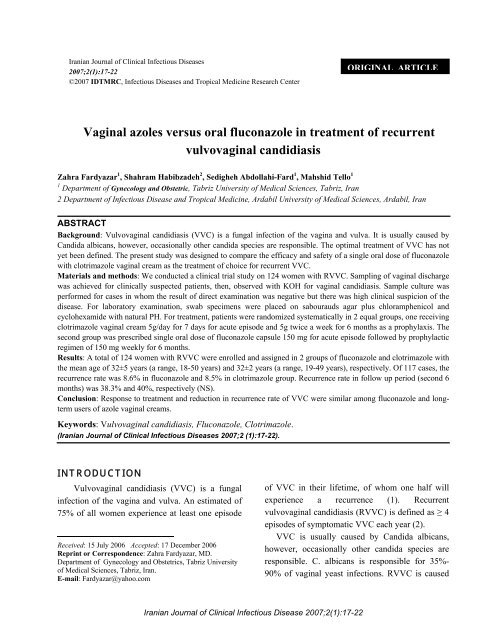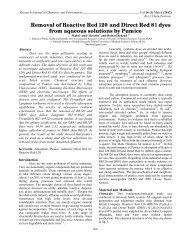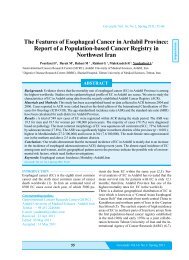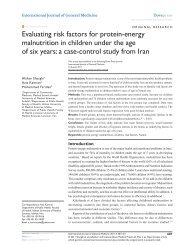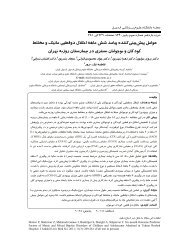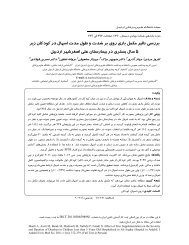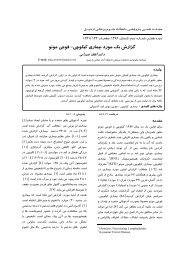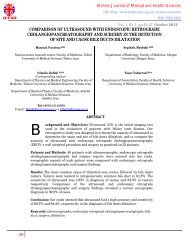Vaginal azoles versus oral fluconazole in treatment of ... - Journals
Vaginal azoles versus oral fluconazole in treatment of ... - Journals
Vaginal azoles versus oral fluconazole in treatment of ... - Journals
Create successful ePaper yourself
Turn your PDF publications into a flip-book with our unique Google optimized e-Paper software.
Iranian Journal <strong>of</strong> Cl<strong>in</strong>ical Infectious Diseases2007;2(1):17-22©2007 IDTMRC, Infectious Diseases and Tropical Medic<strong>in</strong>e Research CenterORIGINAL ARTICLE<strong>Vag<strong>in</strong>al</strong> <strong>azoles</strong> <strong>versus</strong> <strong>oral</strong> <strong>fluconazole</strong> <strong>in</strong> <strong>treatment</strong> <strong>of</strong> recurrentvulvovag<strong>in</strong>al candidiasisZahra Fardyazar 1 , Shahram Habibzadeh 2 , Sedigheh Abdollahi-Fard 1 , Mahshid Tello 11 Department <strong>of</strong> Gynecology and Obstetric, Tabriz University <strong>of</strong> Medical Sciences, Tabriz, Iran2 Department <strong>of</strong> Infectious Disease and Tropical Medic<strong>in</strong>e, Ardabil University <strong>of</strong> Medical Sciences, Ardabil, IranABSTRACTBackground: Vulvovag<strong>in</strong>al candidiasis (VVC) is a fungal <strong>in</strong>fection <strong>of</strong> the vag<strong>in</strong>a and vulva. It is usually caused byCandida albicans, however, occasionally other candida species are responsible. The optimal <strong>treatment</strong> <strong>of</strong> VVC has notyet been def<strong>in</strong>ed. The present study was designed to compare the efficacy and safety <strong>of</strong> a s<strong>in</strong>gle <strong>oral</strong> dose <strong>of</strong> <strong>fluconazole</strong>with clotrimazole vag<strong>in</strong>al cream as the <strong>treatment</strong> <strong>of</strong> choice for recurrent VVC.Materials and methods: We conducted a cl<strong>in</strong>ical trial study on 124 women with RVVC. Sampl<strong>in</strong>g <strong>of</strong> vag<strong>in</strong>al dischargewas achieved for cl<strong>in</strong>ically suspected patients, then, observed with KOH for vag<strong>in</strong>al candidiasis. Sample culture wasperformed for cases <strong>in</strong> whom the result <strong>of</strong> direct exam<strong>in</strong>ation was negative but there was high cl<strong>in</strong>ical suspicion <strong>of</strong> thedisease. For laboratory exam<strong>in</strong>ation, swab specimens were placed on sabourauds agar plus chloramphenicol andcyclohexamide with natural PH. For <strong>treatment</strong>, patients were randomized systematically <strong>in</strong> 2 equal groups, one receiv<strong>in</strong>gclotrimazole vag<strong>in</strong>al cream 5g/day for 7 days for acute episode and 5g twice a week for 6 months as a prophylaxis. Thesecond group was prescribed s<strong>in</strong>gle <strong>oral</strong> dose <strong>of</strong> <strong>fluconazole</strong> capsule 150 mg for acute episode followed by prophylacticregimen <strong>of</strong> 150 mg weekly for 6 months.Results: A total <strong>of</strong> 124 women with RVVC were enrolled and assigned <strong>in</strong> 2 groups <strong>of</strong> <strong>fluconazole</strong> and clotrimazole withthe mean age <strong>of</strong> 32±5 years (a range, 18-50 years) and 32±2 years (a range, 19-49 years), respectively. Of 117 cases, therecurrence rate was 8.6% <strong>in</strong> <strong>fluconazole</strong> and 8.5% <strong>in</strong> clotrimazole group. Recurrence rate <strong>in</strong> follow up period (second 6months) was 38.3% and 40%, respectively (NS).Conclusion: Response to <strong>treatment</strong> and reduction <strong>in</strong> recurrence rate <strong>of</strong> VVC were similar among <strong>fluconazole</strong> and longtermusers <strong>of</strong> azole vag<strong>in</strong>al creams.Keywords: Vulvovag<strong>in</strong>al candidiasis, Fluconazole, Clotrimazole.(Iranian Journal <strong>of</strong> Cl<strong>in</strong>ical Infectious Diseases 2007;2 (1):17-22).INTRODUCTION1Vulvovag<strong>in</strong>al candidiasis (VVC) is a fungal<strong>in</strong>fection <strong>of</strong> the vag<strong>in</strong>a and vulva. An estimated <strong>of</strong>75% <strong>of</strong> all women experience at least one episodeReceived: 15 July 2006 Accepted: 17 December 2006Repr<strong>in</strong>t or Correspondence: Zahra Fardyazar, MD.Department <strong>of</strong> Gynecology and Obstetrics, Tabriz University<strong>of</strong> Medical Sciences, Tabriz, Iran.E-mail: Fardyazar@yahoo.com<strong>of</strong> VVC <strong>in</strong> their lifetime, <strong>of</strong> whom one half willexperience a recurrence (1). Recurrentvulvovag<strong>in</strong>al candidiasis (RVVC) is def<strong>in</strong>ed as ≥ 4episodes <strong>of</strong> symptomatic VVC each year (2).VVC is usually caused by Candida albicans,however, occasionally other candida species areresponsible. C. albicans is responsible for 35%-90% <strong>of</strong> vag<strong>in</strong>al yeast <strong>in</strong>fections. RVVC is causedIranian Journal <strong>of</strong> Cl<strong>in</strong>ical Infectious Disease 2007;2(1):17-22
18 Treatment <strong>of</strong> recurrent vulvovag<strong>in</strong>al candidiasisby the persistence <strong>of</strong> a s<strong>in</strong>gle yeast genotype thatundergoes morphological and behavi<strong>oral</strong> changes<strong>in</strong> the presence <strong>of</strong> antifungal agents (3). Associatedsymptoms and signs <strong>in</strong>clude pruritus, burn<strong>in</strong>g,soreness, abnormal vag<strong>in</strong>al discharge, dysparonia,and vag<strong>in</strong>al and vulvar erythema and edema (4).Known predispos<strong>in</strong>g host factors which <strong>in</strong>cludeuncontrolled diabetes mellitus,immunosuppression, pregnancy, and hormonereplacement therapy, could partly expla<strong>in</strong> RVVC.Broad spectrum antibiotic use has been suggestedas a risk factor for both acute and recurrent VVC.Frequent recurrences <strong>of</strong> symptomaticvulvovag<strong>in</strong>itis result <strong>in</strong> considerable suffer<strong>in</strong>g andhave a markedly negative <strong>in</strong>fluence on sexualrelation (5).The diagnosis should be confirmed by physicalexam<strong>in</strong>ation, direct microscopy <strong>of</strong> the vag<strong>in</strong>alsecretions and, <strong>of</strong> course, fungal culture.Characteristic budd<strong>in</strong>g mycelia are seen <strong>in</strong> fewerthan 30% <strong>of</strong> positive candida cultures (6).The optimal <strong>treatment</strong> <strong>of</strong> VVC has not yet beendef<strong>in</strong>ed (7). Consequently, <strong>treatment</strong> must be<strong>in</strong>dividualized based on a comparison <strong>of</strong>effectiveness, convenience, potential side effects,and costs. Treatment <strong>of</strong> the acute episode usually<strong>in</strong>volves topical application <strong>of</strong> Azoles drugs ornystat<strong>in</strong> or systemic <strong>oral</strong> antifungal agents.However, for recurrent VVC, after <strong>treatment</strong> <strong>of</strong> theacute episode, subsequent prophylaxis(ma<strong>in</strong>tenance therapy) is essential (7). Severalma<strong>in</strong>tenance regimens have been proposed, likeketoconazole 100 mg/day or <strong>fluconazole</strong> 150mgweekly for 6 months (7). Oral <strong>treatment</strong> carries agreater potential for systemic toxicity and drug<strong>in</strong>teraction for pregnant women, diabetic patients,and for whom it is contra<strong>in</strong>dicated (such as thosewith renal or hepatic <strong>in</strong>sufficiency).The present study was designed to compare theefficacy and safety <strong>of</strong> a s<strong>in</strong>gle <strong>oral</strong> dose <strong>of</strong><strong>fluconazole</strong> (150mg) weekly with clotrimazolevag<strong>in</strong>al cream 150 mg twice weekly for 6 monthsas the <strong>treatment</strong> <strong>of</strong> choice for recurrent VVC.PATIENTS and METHODSWe conducted a cl<strong>in</strong>ical trial study on 124women with RVVC. Cases were recruited frompatients present<strong>in</strong>g to the Gynecology andObstetrics Cl<strong>in</strong>ic at Tabriz Medical Universitybetween 2002–2004.Patients with signs and symptoms <strong>of</strong> candidiavulvovag<strong>in</strong>itis (pruritus, irritation, burn<strong>in</strong>g,discharge, erythema and edema) and a history <strong>of</strong>more than 4 episodes <strong>of</strong> VVC dur<strong>in</strong>g the past year(at least one <strong>of</strong> the previous episodes must havebeen diagnosed by physician) were <strong>in</strong>cluded. Thefollow<strong>in</strong>g exclusion criteria were applied atbasel<strong>in</strong>e: severe chronic disease, use <strong>of</strong> <strong>oral</strong>hypoglycemic drugs, chronic dermatologic disease.All subjects were requested to sign an <strong>in</strong>formedconsent, then, social, demographic and medicalfeatures as well as the present compla<strong>in</strong>t <strong>of</strong> thepatient were <strong>in</strong>quired and vag<strong>in</strong>al exam<strong>in</strong>ation wasperformed.Sampl<strong>in</strong>g <strong>of</strong> vag<strong>in</strong>al discharge was achieved forcl<strong>in</strong>ically suspected patients, then, observed withKOH for vag<strong>in</strong>al candidiasis. Sample culture wasperformed for cases <strong>in</strong> whom the result <strong>of</strong> directexam<strong>in</strong>ation was negative but there was highcl<strong>in</strong>ical suspicion <strong>of</strong> the disease. For laboratoryexam<strong>in</strong>ation, swab specimens were placed onsabourauds agar plus chloramphenicol andcyclohexamide with natural PH. The specimenswere stored at 37°C and subsequently identified bysmooth white colony formation. FBS (fast<strong>in</strong>g bloodsugar) test was requested to confirm the unknowndiabetes mellitus, and Pap smear was alsoperformed to rule out pre-cancer lesion <strong>of</strong> thecervix.For <strong>treatment</strong>, patients were randomizedsystematically <strong>in</strong> 2 groups with 62 cases <strong>in</strong> each.The first group received clotrimazole vag<strong>in</strong>alcream 5g/day for 7 days for acute episode and 5gtwice a week for 6 months as a prophylaxis. Thesecond group was prescribed s<strong>in</strong>gle <strong>oral</strong> dose <strong>of</strong><strong>fluconazole</strong> capsule 150 mg for acute episodeIranian Journal <strong>of</strong> Cl<strong>in</strong>ical Infectious Disease 2007;2(1):17-22
Fardyazar Z. et al 19followed by prophylactic regimen <strong>of</strong> 150 mgweekly for 6 months.Patients were visited a week follow<strong>in</strong>g the<strong>in</strong>itiation <strong>of</strong> therapy and then monthly for one year.At each visit, a detailed cl<strong>in</strong>ical history was<strong>in</strong>quired, a pelvic exam<strong>in</strong>ation was performed, anda vag<strong>in</strong>al sample was obta<strong>in</strong>ed for microscopicexam<strong>in</strong>ation. Patients had to discont<strong>in</strong>ue theassigned study <strong>treatment</strong> if they had severecomplication, missed two or more consecutivedoses <strong>of</strong> the drug or had irregular control visits.The recurrence <strong>of</strong> VVC was determ<strong>in</strong>ed by patientcompla<strong>in</strong>t, physical exam<strong>in</strong>ation, and laboratoryf<strong>in</strong>d<strong>in</strong>g (microscopic f<strong>in</strong>d<strong>in</strong>gs or fungal culture).Patients' satisfaction with drug use was evaluatedby <strong>in</strong>terview us<strong>in</strong>g a Likert spectrum.Data were analyzed by SPSS for W<strong>in</strong>dows(version 10.5, USA) and Mann-Withney U-test,Kaplan-Mayer method and chi-square test wereused, when appropriate.RESULTSA total <strong>of</strong> 124 women with RVVC wereenrolled and assigned <strong>in</strong> 2 groups <strong>of</strong> <strong>fluconazole</strong>and clotrimazole with the mean age <strong>of</strong> 32±5 years(a range, 18-50 years) and 32±2 years (a range, 19-49 years), respectively. The ma<strong>in</strong> sociodemographiccharacteristics <strong>of</strong> patients arepresented <strong>in</strong> table 1. These variables showed nosignificant difference between the two groups.As shown <strong>in</strong> table 2, the frequency <strong>of</strong> antibioticuse <strong>in</strong> the past 6 months, contraception method, thehistory <strong>of</strong> diabetes, and results <strong>of</strong> laboratoryf<strong>in</strong>d<strong>in</strong>gs were more or less the same <strong>in</strong> both groups.None <strong>of</strong> the patient was pregnant.The ma<strong>in</strong> symptoms <strong>of</strong> disease were vag<strong>in</strong>alburn<strong>in</strong>g (82.3%), and vag<strong>in</strong>al pruritus (78.2%),however, vulvovag<strong>in</strong>al erythema (87.9%), mucosaledema (79.8%), and white caseouse discharge(68.5%) were more commonly found dur<strong>in</strong>gphysical exam<strong>in</strong>ation. Hav<strong>in</strong>g followed theprescribed regimens, the cure rate at first visit was99%.Table 1. Sociodemographic characteristics <strong>of</strong> patientswith Vulvovag<strong>in</strong>al candidiasisClotrimazole(n=59)Group *Fluconazole(n=58)Literature statusIlliterate 32(54.2) 26(44.8)Diploma 21(35.5) 23(39.6)Graduated 6(10.3) 9(15.6)OccupationHousekeeper 44(74.6) 44(76.0)Employee 15(25.4) 14(24.0)* Groups showed no significant differenceTable 2. Medical characteristics <strong>of</strong> patients withVulvovag<strong>in</strong>al candidiasisGroup *Clotrimazole(n=59)Fluconazole(n=58)Contraceptive methodOCP 12(20.3) 18(31)IUD 9(15.2) 12(20.6)Barrier 5(8.5) 5(8.8)Withdrawal 33(56) 23(39.6)Antibiotic use dur<strong>in</strong>gthe last 6 months17(28) 15(25)Diabetes mellitus 6(10) 7(11.6)Laboratory resultsDirect smear withKOH55(91.6) 57(95)Candida culture 5(8.3) 3(5)Pap smearNormal 41(69.4) 35(60.3)Positive for candida 12(19) 8(13.8)Cervicitis 6(11.6) 15(25.9)* Groups showed no significant differenceDur<strong>in</strong>g the third visit, 2 patients <strong>of</strong> <strong>fluconazole</strong>group were excluded because <strong>of</strong> irregular visitswhile 2 other patients were excluded dur<strong>in</strong>g the 4thand 5th visit because <strong>of</strong> more than 3 times miss<strong>in</strong>gdrug use. On the other hand, <strong>in</strong> the clotrimazoleIranian Journal <strong>of</strong> Cl<strong>in</strong>ical Infectious Disease 2007;2(1):17-22
20 Treatment <strong>of</strong> recurrent vulvovag<strong>in</strong>al candidiasisgroup, 3 patients were excluded <strong>in</strong> the 2nd and 3rdvisit because <strong>of</strong> local sensitivity to the drug.Of rema<strong>in</strong><strong>in</strong>g 117 cases, as presented <strong>in</strong> table 3,the recurrence rate was 8.6% <strong>in</strong> <strong>fluconazole</strong> groupand 8.5% <strong>in</strong> clotrimazole group. Recurrence rate <strong>in</strong>follow up period (second 6 months) was 38.3% and40%, respectively (NS).Table 3. Recurrence rate <strong>of</strong> vulvovag<strong>in</strong>al candidiasisamong the two groups dur<strong>in</strong>g <strong>treatment</strong> and follow-upperiodGroup *Clotrimazole(n=59)Fluconazole(n=58)Treatment period (first 6 months)1-6 months 5(8.5) 5(8.6)Follow-up period7 th month 3(5.1) 3(5.2)8 th month 0 2(3.5)9 th month 2(3.4) 3(5.2)10 th month 5(8.5) 4(6.9)11 th month 5(8.5) 5(8.6)12 th month 5(8.5) 6(10.3)Total recurrence (dur<strong>in</strong>ga 12-month period)25(42.4) 26(44.8)* Groups showed no significant differenceTable 4. Quality <strong>of</strong> drug use and satisfaction <strong>in</strong> bothgroupsGroup *Clotrimazole(n=59)Fluconazole(n=58)Completion <strong>of</strong> regimen protocolComplete 55(93.2) 49(84.4)1 miss<strong>in</strong>g dose 3(5.0) 5(8.6)2 miss<strong>in</strong>g doses 1(1.8) 4(7.0)Patient's satisfactionVery good 19(32.2) 10(17.2)Good 15(25.4) 14(24.4)Relatively good 13(21.7) 9(15.5)Relatively bad 8(13.3) 9(15.5)Bad 2(3.3) 8(13.7)Very bad 2(3.3) 8(13.7)Totally, 88.8% <strong>of</strong> cases <strong>in</strong> <strong>fluconazole</strong> groupand 85% <strong>of</strong> cases <strong>in</strong> clotrimazole group used theirdrug regularly. Drug usage miss<strong>in</strong>g rate (missed ≥2consecutive doses <strong>of</strong> the drug) was 4 cases <strong>in</strong><strong>fluconazole</strong> and 9 cases <strong>in</strong> clotrimazole group,respectively. Local cream users were more satisfiedwith their regimen (p
Fardyazar Z. et al 21more difficult (11). In our study, the rate <strong>of</strong> falsenegativef<strong>in</strong>d<strong>in</strong>g <strong>of</strong> direct exam<strong>in</strong>ation was 6.3%which was confirmed by fungal culture, <strong>in</strong>dicat<strong>in</strong>gthe test reliability.Broad spectrum antibiotic use, use <strong>of</strong> comb<strong>in</strong>ed<strong>oral</strong> contraceptives, pregnancy, diabetes,immunosuppression, and hormone replacementtherapy (12) are positively associated withsymptomatic vulvovag<strong>in</strong>al candidiasis episodes (8).In our study, OCP use (12 cases), antibiotic use (33cases), and diabetes mellitus (13 cases) were thepredispos<strong>in</strong>g factors. In a case-control study over684 cases with symptomatic VVC and 901 controls(asymptomatic women), 19.3% <strong>of</strong> cases and 11.9%<strong>of</strong> controls were antibiotic users while VVC wasrevealed to be directly related with antibiotic use(13). Bohannon suggested that hyperglycemia isthe major cause <strong>of</strong> <strong>in</strong>creased susceptibility <strong>of</strong>diabetic patients to VVC. Increased glucose levels<strong>in</strong> genital tissues enhance yeast adhesion andgrowth. Beg<strong>in</strong>n<strong>in</strong>g at levels <strong>of</strong> 10-11mmol/L (180-196 mg/dl), hyperglycemia may impair severalaspects <strong>of</strong> hum<strong>oral</strong> host defense, result<strong>in</strong>g <strong>in</strong>decreased random motion <strong>of</strong> neutrophils,chemotaxis, phagocytosis, and microbial kill<strong>in</strong>g(11). In our study, because <strong>of</strong> small number <strong>of</strong>diabetic patients, the analysis <strong>of</strong> studied drugregimen effect on this disease is impossible,although, because <strong>of</strong> <strong>in</strong>teraction between<strong>fluconazole</strong> and hypoglycemic drugs, use <strong>of</strong>vag<strong>in</strong>al clotrimazole with the same efficacy andlower side effects is recommended.Patel et al. suggested that cloth<strong>in</strong>g habits,personal hygiene, a history <strong>of</strong> bacterial vag<strong>in</strong>osis,consumption <strong>of</strong> acidophil-conta<strong>in</strong><strong>in</strong>g products, andage
22 Treatment <strong>of</strong> recurrent vulvovag<strong>in</strong>al candidiasis6. Jovanovic R, Conjgema E, Nguyen HT. Antifungalagents vs. boric acid treat<strong>in</strong>g chronic mycoticvulvovag<strong>in</strong>itis. J Reprod Med 1991;36:593-7.7. R<strong>in</strong>gdahl EN. Treatment <strong>of</strong> recurrent vulvovag<strong>in</strong>alcandidiasis. Am Fam Physician 2000;61(11):3306-12.8. Scott JR, Gibbs RS, Karlan BY, et al, editors.Danforth’s Obstetrics & Gynecology. 9 th edition.Lip<strong>in</strong>cott Williams & Wilk<strong>in</strong>s, Philadelphia,2003;p:583-84.9. Sper<strong>of</strong>f L, Glass RH, Kase NG. Cl<strong>in</strong>icalgynecologic endocr<strong>in</strong>ology and <strong>in</strong>fertility. 6 th edition.Lip<strong>in</strong>cott Williams & Wilk<strong>in</strong>s, Philadelphia, 2004;p:746-810.10. Nyirjesy P. Chronic vulvovag<strong>in</strong>al candidiasis. AmFam Physician 2001;63(4):697-702.11. Bohannon NJ. Treatment <strong>of</strong> vulvovag<strong>in</strong>alcandidiasis <strong>in</strong> patients with diabetes. Diabetes Care1998;21(3):451-6.12. Patel D, Cillespie B, Sobel J, et al. Risk factors forrecurrent <strong>fluconazole</strong> candidiasis <strong>in</strong> womenreceiv<strong>in</strong>g ma<strong>in</strong>tenance antifungal therapy. Am J ObstetGynecol 2004;190:644-53.13. Sp<strong>in</strong>illo A, Capuzzo E, Acciano S, et al. Effect <strong>of</strong>antibiotic use on the prevalence <strong>of</strong> symptomaticvulvovag<strong>in</strong>al candidiasis. Am J Obstet Gynecol1999;180:14-7.14. Sobel J, Brooker D, Sta<strong>in</strong> G, et al. S<strong>in</strong>gle <strong>oral</strong> dose<strong>fluconazole</strong> compared with conventional clotrimazoletopical therapy <strong>of</strong> candida vag<strong>in</strong>itis. Am J ObstetGynecol 1995;172:1263-8.15. Sadovsky R. Treat<strong>in</strong>g complicated candida with<strong>fluconazole</strong>. Am J Obstet Gynecol 2001;185:363-9.Iranian Journal <strong>of</strong> Cl<strong>in</strong>ical Infectious Disease 2007;2(1):17-22


